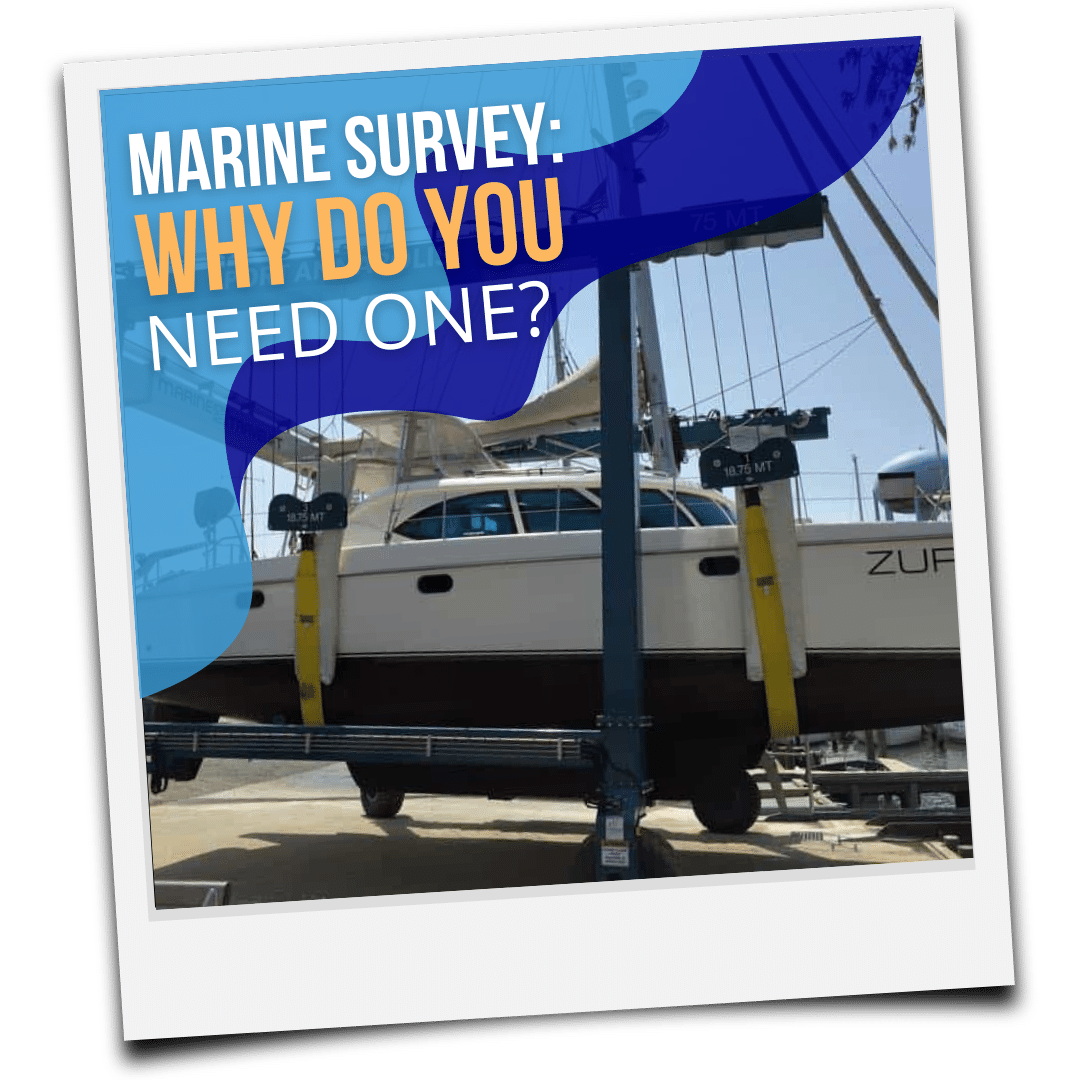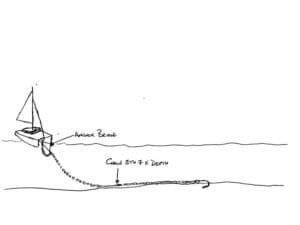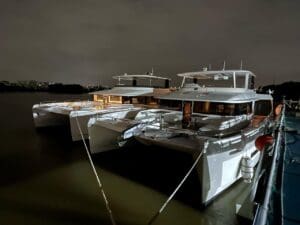
We highly recommend that every prospective buyer of a pre-owned yacht get a marine survey done before any money changes hands! A marine survey is a detailed inspection of a yacht by an accredited marine surveyor to determine its current condition.
More importantly, it will determine the yacht’s seaworthiness and whether the vessel is safe to operate in the conditions for which it was designed.
How to Use Your Marine Survey
Many boat buyers think of a marine survey as a way to find all the needed repairs so they can negotiate the final terms of their purchase. But, a survey should help you cement that this is the right vessel for you. It should convince you to buy or to walk away.
Often walking away can feel brutal after a long hunt for your dream boat, but keep this option in mind and your emotions at bay during the survey period as it may be the most prudent decision.
Boats and how they are equipped vary widely so creating a standard for a survey checklist is not practical. That is why it is important to hire an experienced and well-informed surveyor. Our recommendations for how to find such a surveyor follow. And though not exhaustive, we have shared a sample marine survey checklist.
A good surveyor will be able to point out major problems, e.g., de-lamination or blisters and smaller deficiencies like gel coat repairs or hatch leaks. With this list in hand, one can make a good determination of what it costs to take care of the major issues and whether the smaller issues are easy enough to deal with over time. Once you determine that the major stuff is not a deal breaker, you can move on to figure out from the survey results, what else is needed to put the vessel in good working order as well as repairs / maintenance / replacements likely to be required in the near future such as new sails or new lines.
So the survey will give you a good evaluation of the general condition of the yacht and give you a good insight into the maintenance required to keep the boat in good shape. Most buyers are not experienced enough and cannot make an adequate evaluation of the condition of the boat and therefore need a survey.
A marine survey is buying peace of mind. Not only will it give you a good idea of exactly what you are getting into with your boat purchase, it is unlikely that you will be able to secure insurance or financing without providing the insurance company or lender with an acceptable survey. So it totally makes sense to pay for that survey. It is cheap at the price for your peace of mind!
Where To Get A Survey for Your Boat
There are several surveyor organizations such as the National Association of Maine Surveyors (NAMS) or Society of Accredited Marine Surveyors (SAMS), but keep in mind that membership is not a true indication of of competency.
Note that because these associations have rigorous examinations for membership, marine insurance underwriters will accept value surveys or pre-purchase surveys from these surveyors in these associations.
As brokers, we give our clients a choice of 3 or 4 surveyors that we have experience with in the area the boat is situated. We ask our buyers to research the surveyors’ reputations online as well as look for others’ recommendations. Then once they have a short list, buyers should directly contact surveyors to interview them and decide who they want to work with. The surveyor is the buyer’s trusted advisor and you should never hire a surveyor based on the recommendation of your broker…including us! It is important you are confident there is no conflict of interest and that you can communicate well with the surveyor.
While interviewing surveyor candidates, be sure to emphasize this is your one and only chance to identify issues to negotiate or that prompt you to walk away. The only way to ensure you have the best possible list of flaws and concerns is to require the surveyor to test every bit of functionality and each piece of equipment. Engines, genset, winches, windlass, sails and sheets, navigational equipment, galley equipment, mechanicals throughout the boat such as faucets, drains, and light switches. Reiterate that you expect the surveyor to fully test everything. If you get push-back or an unsettling feeling this is not what the surveyor usually does, move on to the next surveyor on your short list.
A few things to consider asking a potential surveyor:
- Are you in good standing with your surveying organization? Keeping proper membership usually always requires completion of continuing-education credits annually which means they should be up to date on their skills and industry information.
- Do you belong to the American Boat and Yacht Council? Many boat buyers may not consider this, but this is a sign that your surveyor has the knowledge and tools to evaluate your boat you are considering against ABYC standards. And that is definitely what you want.
- Have you earned any certifications? This shows that the surveyor is serious about the quality of their services. Though not a requirement, it would definitely be a differentiator as ABYC certifications such as “Systems”, “Electrical”, or “Engines”.
- Can you evaluate the vessel for compliance with all relevant, current ABYC standards? (more on this below)
Note you should check any memberships or certifications before hiring the surveyor.
Evaluating a Boat for ABYC Standards
When your surveyor discusses the results with you, you want to know if the vessel inspection revealed any ABYC standards violations. Often these will be “violations” because the boat was built before the standard was implemented. And that is an acceptable answer from the seller or broker, especially since there is no legal requirement that the standards be followed such as sound signaling devices, emergency equipment, or navigation lights.
But, decide for yourself if any particular lack of compliance with a standard means the boat is not for you. You can still buy homes built with old electrical wiring techniques that are risky for electrocution or fires. Would you live in that home with those risks? Probably not, since an investment of time and money could eliminate the risk.
The same should hold true for any ABYC violation found on the boat you are considering. Plan to eliminate any unnecessary risks either by negotiating with the seller to have the proper technician make the repair or to reduce the price so you can do so.
Learn More about Marine Surveys
For more interesting reading about marine surveys, try reading this great article, Marine Survey 101, Understanding boat surveys: What is pre-purchase or Marine Surveyors Earn Their Fee and here is a pre-survey checklist when considering a yacht to help you weed out the good ones from the bad ones BEFORE you spend any money.
Typical Marine Survey Checklist
Surveys vary a bit from firm to firm but they basically include a review of the condition and working order of the structure, finishes, and systems. Download our Marine Survey Checklist to get a better understanding of what to expect. It is also a great list for you to use to prepare your boat for sale as you can eliminate many of the price negotiation points ahead of time by repairing any deficiencies.
| Survey Checklist | Done |
| Engines | |
| Run & test port start/idle/full ahead/astern/stop | |
| Run & test stbd. start/idle/full ahead/astern/stop | |
| Is alarm system operational? | |
| Proper instrument readings. | |
| Observe exhaust water discharge for proper volume | |
| Feel exhaust hose for heat as evidence of H2O restriction in exhaust elbow | |
| Smooth operation? Excessive smoke exhaust, smell in & out of engine room | |
| Operational bilge blower | |
| Sea trial-check for vibrations & misalignment | |
| Preseason dive/hull inspection | |
| gauges | |
| alarms | |
| keys/spare | |
| sound insulation | |
| engine grounding plate | |
| Tanks | |
| gauges | |
| alarms | |
| switchover | |
| valves/crossover | |
| Batteries | |
| access | |
| tie down & labeling | |
| charge level | |
| switchover – emergency start | |
| Plumbing | |
| Test operation of Lectrasan (check correct gauge reading) | |
| Check through hull valves for leaks, free operation & corrosion, check hoses & clamps | |
| Hoses double clamped? | |
| Open & service in-line strainers, check for leaks, remote bilge & sump pumps & filters. | |
| Automatic Bilge Pumps-confirm operation of float switches. | |
| Manual Bilge Pumps-confirm operation and strainer installed at pick up, handle secured? | |
| Sump Pump-confirm operation, strainer cleaned & installed, float switch operation? | |
| Fresh Water Pressure System-confirm operation of pump & all related fixtures. | |
| Head operation-confirm operation, check for leaks, lube as needed. | |
| Y-Valves-confirm operation, lube as needed, handle restrained per USCG? | |
| Age of hoses (under 5 years) | |
| Holding Tanks-check for leaks & odors, deck pump out cap free, tank empty? Flush with clean water. | |
| Macerator: confirm operation, leaks or odor, momentary switch at pump | |
| Macerator: verify pump actually discharges liquids | |
| Wire tie head Y-Valve discharge to prevent direct dumping from heads | |
| Bilges | |
| Bilges clean/free of debris | |
| Rust in engine compartment | |
| Clean engine room | |
| Mechanical | |
| Steering-check cable tension routing & condition (chafe). | |
| Steering-Hydraulic, check fluid level in reservoir, check for leaks, inspect hoses & rudder linkage. | |
| Engine controls-proper adjustment smooth operation. | |
| Engine Exhaust System double clamped, hoses checked. | |
| Engine Hoses & cable inspected for chafe. | |
| Sea Strainer checked; service strainer & O-rings | |
| Stuffing Box-check hose, double clamp if needed, is there adjustment left or does it require repacking? | |
| Corrosion on adjacent surfaces? Spray deflector needed? | |
| Windshield wipers & motor | |
| Electrical DC | |
| Check battery condition with load tester | |
| check operation of all lights in cabins | |
| check operation of all courtesy lights | |
| check fan operation | |
| Check battery fluid level, terminals clean & tight | |
| Cables neatly organized (they don’t block battery fill caps) | |
| Battery boxes secured & covered | |
| DC switch panel-test all circuits, lights, pumps, electronics, etc. (all switches labeled?) | |
| Navigation lights checked-running lights, steaming light, anchor light, compass & instruments | |
| 12 Volt plug in at or near each steering station | |
| Do all switches work? | |
| Stock of distilled water for Batteries | |
| electrical grounding | |
| Electrical AC | |
| Power cord condition, cord end fittings & receptacles | |
| Operate major AC appliances: H2O heater, cabin heat, refrigerators, chargers. | |
| GFI installed in galley, heads & exterior? | |
| AC adapters-15-30 AMP & 20/30 AMP in ships inventory? 50 AMP? | |
| Operate AC generator & confirm proper output. | |
| Extension cord adaptor | |
| check shore power connection/generator switchover (correctly labeled) | |
| Dinghy & Accessories | |
| Appearance | |
| Davits | |
| O/B Mounting Bracket | |
| Oars, patch kit, plug, pump, gear bag | |
| O/B fuel can – mark with fuel type | |
| Inflatable dinghy-hold pressure | |
| Name & hailing port | |
| O/B Motor HP | |
| Serial # | |
| Outboard | |
| Check lower unit oil | |
| Fuel | |
| Fittings greased | |
| Moving parts lubricated | |
| Rust preventer sprayed on all engine & metal parts | |
| Are all metal parts rust free? | |
| Are water drain holes in gear housing open so water can drain out? | |
| Engine starts and runs | |
| Spare shear pins & spark plugs | |
| Canvas Covers | |
| Dinghy Covers | |
| Chafe Strips | |
| Enclosures | |
| Snaps & Fasteners | |
| Barbecue Cover | |
| Table Cover | |
| Cushions | |
| Sails | |
| condition | |
| reef points | |
| covers | |
| lazy bag and lazy jacks | |
| UV covers | |
| sail numbers/markings/decorations | |
| mainsail. jib, gennaker, spinnaker | |
| Running Rigging | |
| bowsprit | |
| shrouds and turnbuckles | |
| furlers | |
| lines | |
| lines storage | |
| Mast | |
| mast base | |
| shrouds | |
| ball bearing luff cars (operation, condition, spares) | |
| running back stays | |
| mast/through deck fitting | |
| mast mounted equipment | |
| chafing gear | |
| cotter pin and locks | |
| lighting protection | |
| antennae and radar mounts | |
| deck, nav, search lights | |
| Mooring & Anchoring | |
| Anchor chain markings | |
| spare line | |
| Anchor packages (2) (stowage system for 300’ mooring line) | |
| dock lines | |
| Spring lines | |
| Boat hook | |
| Anchor windlass operation | |
| Fenders (4) & Spares (2) (optional) | |
| Windlass handle | |
| Markings both primary and secondary chain/rode-distances noted in manual | |
| Measurements of both size & length for chain/rode-noted in inventory/manual | |
| Extra mooring line length ft. Size | |
| Exterior Condition | |
| Antifouling | |
| Anodes | |
| Storage lockers/drains and ventilation | |
| Wax | |
| Gel Coat Repairs (kit) | |
| Painting | |
| Bright work Varnish | |
| Venturi/Wind Screen | |
| Windows/Doors | |
| Teak Decks | |
| American Flag | |
| GB Burgee | |
| Bow Staff | |
| Flag Staff | |
| Canadian Courtesy Flag | |
| Interior Condition | |
| Headliner | |
| Window tracks | |
| Woodwork finish | |
| Upholstery | |
| Carpets | |
| Shower curtains/teak grates/shower sumps | |
| Cabin sole | |
| Curtains/tie backs/snaps | |
| Countertops | |
| Head Compartments | |
| Door & locksets (interior & exterior) | |
| Screens | |
| Refrigerator Drain Plugs | |
| Refrigerator Shelf hangers/clips | |
| Stove knobs & pot holders | |
| Machinery: Main Engines & Generator | |
| Check fluid levels-glycol, oil, trans oil | |
| Inspect water fuel separator for contamination | |
| Check belt tension & condition | |
| Inspect air intake screen or filter & replace or clean as needed | |
| Determine oil & filter service history. Service required Y N | |
| Electronics & Navigation | |
| VHF radio(s)-test operation on CH16 & 68, antenna connection tight | |
| Depth sounder in good operation, clean knot meter paddlewheel | |
| Loran/GPS & Radar-test operation | |
| Chart plotter-test operation, inventory cartridges | |
| Stereo-test operation of received & tape/CD deck, check all speakers | |
| Compass alignment needed? Deviation table posted | |
| TV/VCR test operation of both | |
| Are operation manuals on board for all equipment | |
| Weather boots/covers on exposed switches | |
| Laptop connectors | |
| Equipment Inspection | |
| Spare Parts inventory complete (see attachment) | |
| Spares in storage box (put in proper storage area) | |
| Tools: condition, adequate inventory in box (put in dry storage area) | |
| Spare keys (6) | |
| Stove LPG /Electric System to code | |
| Propane compartment open to living spaces | |
| Electric/convention/microwave/ovens | |
| Weather boots on all exposed toggle & push button switches | |
| Expiration date for old propane bottles | |
| Deck Hardware & Hatches | |
| check trampoline condition, lashing | |
| Check hatches – mounting, drains, locks, location | |
| deck hardware backing plates | |
| winches | |
| cleats | |
| vents – drainage | |
| lockers and latches | |
| stanchions and mounting | |
| Galley Equipment | |
| sink and drain | |
| saltwater/fresh water system | |
| microwave | |
| ventilation | |
| stove | |
| oven | |
| trash compactor | |
| refrigeration | |
| freezer | |
| bar- icemaker | |
| dishwasher | |
| Miscellaneous Equipment | |
| Check heater operation | |
| Check air-conditioning operation in each cabin | |
| Salt water wash down & hose | |
| washer drier operation | |
| Check davit winch; proper lead? frayed cables? Remote Control. | |
| Check O/B for operation; locking method. | |
| Operation Manuals-are they in with the other ships papers? Do they cover operation of all systems | |
| sufficiently? | |
| Safety Equipment | |
| check life raft expiration, location, access, lashing | |
| deck lifelines | |
| under hull/bridgedeck lifelines | |
| transom boarding ladder and access from water for re-entry | |
| PFD’s sleeping capacity plus 2, plus 2 child’s (optional) | |
| Flares-3 handheld or 3 meteor flares, check expiration date (3 years from the month indicated on the | |
| flares) | |
| Ships bell-all boats | |
| Air horn-all boats (back up handheld for power boats) | |
| Fire extinguishers-how many check expiration date – – | |
| Throw able ring or horseshoe with line or life sling | |
| First Aid Kit-contents & condition, replace as needed | |
| Life lines & railings-tension & condition of cables, stanchions, railings & gates | |
| USCG auxiliary inspection | |
| emergency tiller | |
| Propane | |
| Vent | |
| Barbecue securely mounted to rail | |
| Check tanks for condition-rusty? Securely mounted? Enclosure vented? Bottle expiration? | |
| Operate all propane appliances – all stove burners & oven | |
| Check hose & connections for wear or chafe from tank to appliance | |






